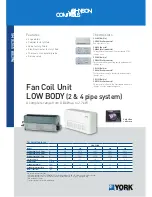
Pressure/Vacuum Pump Kit
ENG
The VACUUM GUN WITH SUCTION AND PRESSURE FUNCTION
made by FÖRCH is an essential tool which
can be used for a number of tests in vacuum systems.
The hand pump and the corresponding attachments can be used to test different vacuum valves, vacuum
units or cylinders as well as to check all components or systems working with vacuum / pressure and
requiring sufficient sealing. The pump and the accessories included in the delivery are also appropriate to
bleed braking systems (e.g. of motorbikes) and fuel filters for diesel systems.
Further examples of application:
• Vacuum-controlled regulating flaps in heating and ventilation systems
• Vacuum units in the motor management (e.g. guide vane pitch adjustment of turbo chargers)
• Leak test of fuel lines
• Pressure sensors
• Vacuum fuel valves (motor cycles, scooters)
1. VACUUM GUN WITH SUCTION AND PRESSURE FUNCTION
The vacuum gun is a precise, robust and easy-to-operate tool. The main unit of the tool is the pump body (A),
the mobile handle (B) and the manometer (C) which displays the attained vacuum (in Hg / bar) as well as the
available pressure (psi / bar). The pressure resp. vacuum mode can be selected as follows by means of the
adjustment mechanism (D):
1.1
Turn the adjustment mechanism until the selection arrow points to the marking “IN” for vacuum testing.
(Fig. 1)
1.2.
Turn the adjustment mechanism again until the selection arrow points to the marking “OUT” for pressure
testing (Fig. 2)
ATTENTION
Although the pressure gun is a tool which was manufactured from high-quality material according to highest
quality requirements, you should always think of it being a precision tool. Therefore, you should handle the
device with care. The use under extremely hot temperatures (motors, manifold system, etc.) can affect the
measuring accuracy of the tool and possibly result in an expiry of warranty claims.
2. ASSEMBLY INSTRUCTIONS FOR BLEEDING BRAKE FLUID
2.1.
Fix one of the hoses of a length of 3” to the hand pump and to the lid of the collection container (single
connection A, refer to Fig. 3).
2.2.
Open the bleeding cup and fix another hose of a length of 3” to the bottom of the lid (B) and close it
hermetically.
2.3.
Then plug the hose of a length of 24“ to the remaining connection of the lid. (C)
2.4
. Choose an adapter among the adapters included in the delivery which fits the drain hose (Fig. 4)
2.5.
Connect the adapter to the bleed nipple of the disc brake caliper.
2.6.
Position a wrench on the bleed screw of the disc brake caliper; do not loosen the bleed screw yet
(Fig. 5).
2.7.
Convince yourself that the hand pump is switched to the mode “IN“ and pump 15 to 20 times in order to
generate vacuum.
2.8.
Then unscrew the bleed screw of the disc brake caliper and the brake fluid is sucked into the collection
container.
2.9.
Remove about 60 ml of the brake fluid; then tighten the bleed screw of the caliper again (Fig. 6).
2.10.
Repeat the process with the remaining brake calipers / brake chambers (Fig. 7).
2.11.
Please make sure to always refill the compensation tank with new brake fluid!






































